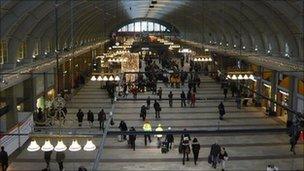Harvesting energy: body heat to warm buildings
- Published
About 250,000 people pass through Stockholm's Central Station each day
Body heat is not an energy source that normally springs to mind when companies want to keep down soaring energy costs.
But it did spring to the mind of one Swedish company, which decided the warmth that everybody generates naturally was in fact a resource that was going to waste.
Jernhusen, a real estate company in Stockholm, has found a way to channel the body heat from the hordes of commuters passing through Stockholm's Central Station to warm another building that is just across the road.
"This is old technology being used in a new way. The only difference here is that we've shifted energy between two different buildings," says Klas Johnasson, who is one of the creators of the system and head of Jernhusen's environmental division.
"There are about 250,000 people a day who pass through Stockholm Central Station. They in themselves generate a bit of heat. But they also do a lot of activities. They buy food, they buy drinks, they buy newspapers and they buy books.
Excess body heat
All this energy generates an enormous amount of heat. So why shouldn't we use this heat. It's there. If we don't use it then it will just be ventilated away to no avail."
So how does the system work in practice?
Heat exchangers in the Central Station's ventilation system convert the excess body heat into hot water.
That is then pumped to the heating system in the nearby building to keep it warm.
Not only is the system environmentally friendly but it also lowers the energy costs of the office block by as much as 25%.
"This is generally good business," says Mr Johansson. "We save money in energy costs and so the building becomes worth more.
"We are quite surprised that people haven't done this before. For a large scale project like Kungbrohuset (the office block) this means a lot of money."
Over the next 40 years, most experts agree that the supply of oil and gas will become less abundant.
There will be strong competition and higher prices for the resources that remain. Given the abundance of human body heat worldwide and the growing need for renewable energy to replace costly fossil fuels - is this Swedish idea going to catch on?
Costs and benefits

Stockholm's Central Station is one building reusing heat from passengers passing through
"People are now starting to think about urban heat distribution networks everywhere," says Doug King, a consultant specialising in design innovation and sustainable development in construction.
"But the financial costs and the benefits will depend very much on the climate and the pricing of energy in a particular country."
He explains that harnessing body heat works particularly well in Sweden because of their low winter temperatures and high gas prices.
Spin offs
"It means a low-grade waste heat source, like body heat, can be used advantageously. It's worth them spending a little bit of money on electricity to move heat from building to building, rather than spending a lot on heating with gas."
Mr Johansson is hoping there will be a lot of spin offs from their idea at Stockholm Central Station: "To get energy usage down in buildings what we need to do is use the energy that is being produced all around us.
"We own both Central Station and Kungbrohuset along with the land in between. So we are in charge of all of it and that has made it easier for us. But this doesn't mean that it cannot be done otherwise. It just means that real estate owners have to collaborate with each other."
He also advocates sustainability. "It's important in Sweden. But it should be important everywhere. Sustainability is the key ingredient to the future of mankind. We need to get sustainable with energy if we are supposed to live on this planet for a long time to come."
But what about the Swedish commuters in the station - will they be the ones left out in the cold?
"The commuters won't get chilly because we don't steal energy from Central Station we use excess heat that was already there before," says Mr Johansson.
So, with its freezing winters, green credentials and high energy costs, Sweden takes a creative approach to heating.
To stay warm all they need to do is keep the heat on. And, if Stockholm's Central Station stays busy then for one building at least it is well on the road to a low carbon and energy secure future.